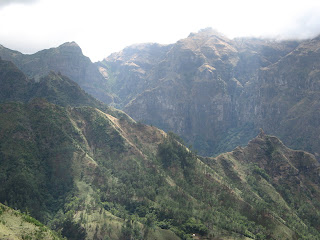Day 3 and the weather looked better than the previous two days had served up so we decided to head inland to
Ribeiro Frio to both
explore the path out to the viewpoint at
Balcoes and to walk one of the l
evadas by the town. We decided to get up early to give ourselves the best chance of seeing the islands specialities, including the
Trocaz Pigeon.
I forgot of course that at altitude the temperature is much lower and as we climbed towards
Ribeiro Frio, the temperature plunged from a warm 22
Celsius to a chilly 10, so we decided on a quick cuppa before setting off. The walk to the viewpoint at
Balcoes is well signposted and there's a handy cafe en route, which had we known about we'd have stopped off there instead, as it has great views from the balcony.
Along the path we spotted this female
Blackcap, or rather heard her and used the sound to locate her:
 Close by
Close by was a large group of
Chaffinches, maderensis, birds which show notable colour and sound differences to the
familiar UK species. This male is a good example:

The commonest bird in the forest though is the
Firecrest, maderensis, they're literally hundreds and hundreds of them. You know their about through the very high pitched calls they make amongst the flock, often from all around you. They also get very close, but move about exceedingly rapidly, often not staying put long enough to get a focus on. In addition they are birds at home within the woods, so the light makes getting a snap very tricky. Over the course of the whole trip I attempted over 100 snaps of these birds to get three
usable photos,
including this one:

From the viewpoint at
Balcoes the views are indeed dramatic and worth the walk. No sign of the
Trocaz Pigeons though, which was
frustrating.

We headed back to
Ribeiro Frio for another cuppa and to buy some snacks for the
levada walk. On the way out to the viewpoint we passed two people, on the way back we must have passed about sixty.
Ribeiro Frio was absolutely heaving with tourists, tourist buses, etc. so we decided to (a) start our trips even earlier for the remainder of the week and (b) to get out on the walk as swiftly as possible.
En route there were plenty more Chaffinches and
Firecrests, including this chap:

but no sign of the
Trocaz Pigeons. We did see a pair of pigeons fly off lower down in the forest but too briefly to be sure... we also heard cooing close-by but couldn't locate the bird(s). The walk out from
Ribeiro Frio on the
Furado levada was very pleasant if a little 'hairy' in places, though the most visible precipitous drops had some limited fencing, as it was all downhill, following the flowing water. We turned off at the bridge and headed up alongside a much smaller and less well formed
levada. What we hadn't realised was that the circular walk we had planned involved climbing much higher than we had thus far descended as the final portion of the loop was a steep downhill section. The climb was a very tough 90 minutes up to a quite stunning area above the forest, which you can see here:

Just over the ridge is a farm, and beyond it the track over the top of the ridge and the descending path. We couldn't hang around too long to take in the view, as again rain clouds were gathering on the horizon. On the way back down the path was so steep and the rain imminent, we decided to use the road, which provided us with a unique experience. There was a large number of
Plain Swifts in the air, getting lower and lower as the weather closed in. The roadway must have had a high concentration of insects as the swifts were flying in along the road and back out at breakneck speed. You can see from this photo what they were doing:

They were flying remarkably close to us as we walked down the road, and often as they were coming down from behind us you heard them before you saw them, as they flew right over our heads or alongside. It was quite an amazing experience watching them repeat this over and over again.






































